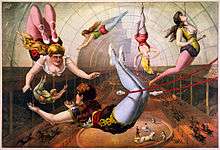Unicycle
A unicycle is a vehicle that touches the ground with only one wheel. The most common variation has a frame with a saddle, and has a pedal-driven direct drive. A two speed hub is commercially available for faster unicycling. Unicycling is practiced professionally in circuses, by street performers, in festivals, and as a hobby. Unicycles have also been used to create new sports such as unicycle hockey. In recent years, unicycles have also been used in mountain unicycling, an activity similar to mountain biking or trials.
History
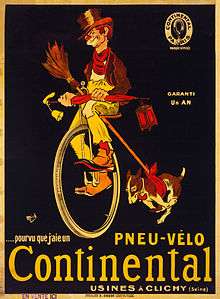
US patents for single-wheeled 'velocipedes' were published in 1869 by Frederick Myers[1] and in 1881 by Battista Scuri.[2]
Unicycle design has developed since the Penny Farthing and later the advent of the first unicycle into many variations including: the seatless unicycle ("ultimate wheel") and the tall ("giraffe") unicycle. During the late 1980s some extreme sportsmen took an interest in the unicycle and modified unicycles to enable them to engage in off-road or mountain unicycling, trials unicycling and street unicycling.
Unicycles compared to other pedal powered vehicles
Bicycles, tricycles and quadracycles share (with minor variations) several basic parts including wheels, pedals, cranks, forks, and the saddle with unicycles. Without a rider, unicycles lack stability – however, a proficient unicyclist is usually more stable than a similarly proficient rider on a bicycle as the wheel is not constrained by the linear axis of a frame. Unicycles usually, but not always, lack brakes, gears, and the ability to freewheel.
Construction
Unicycles have a few key parts:
- The wheel (which includes the tire, tube, rim, spokes, hub and axle)
- The cranks (which attach the pedals to the wheel hub)
- The hub (connects the spokes to a central point and also transfers pedaling power to the wheel)
- Pedals
- Fork-style frame
- Seatpost
- Saddle (the seat of the unicycle)
The wheel is usually similar to a bicycle wheel with a special hub designed so the axle is a fixed part of the hub. This means the rotation of the cranks directly controls the rotation of the wheel (called direct drive). The frame sits on top of the axle bearings, while the cranks attach to the ends of the axle, and the seatpost slides into the frame to allow the saddle to be height adjusted.
Types of unicycles

Types of unicycle include:
- Freestyle unicycles
- Trials unicycles
- Mountain unicycles (also called Munis)
- Giraffe unicycles
- Commuter unicycles
- Street unicycles
- Cruiser unicycles
- Road unicycles
Each type has various combinations of frame strength, wheel diameter, and crank length.
Freestyle unicycles
Generally used for flatland skills and freestyle routines, freestyle unicycles typically have a relatively high seatpost, a narrow saddle, and a squared fork (used for one-footed tricks). These unicycles are used similarly to flatland bicycles. Wheel size is usually 20 inches (510 mm), but smaller riders may use 16-or-12-inch (410 or 300 mm) unicycles. Some people prefer 24-inch (610 mm) wheels.
Trials unicycles
Designed for unicycle trials, these unicycles are stronger than standard unicycles in order to withstand the stresses caused by jumping, dropping, and supporting the weight of the unicycle and rider on components such as the pedals and cranks. Many trials unicycles also have wide, 19- or 20-inch (510 mm) knobby tires to absorb some of the impact on drops.
Mountain unicycles ("Munis")
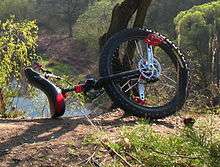
Mountain unicycling (abbreviated to muni) consists of riding specialized unicycles on mountain bike trails or otherwise off-roading. Mountain unicycles have thicker, wider tires for shock absorption. Many riders choose to use long cranks to increase power when riding up hills and over rough terrain. A disk brake is sometimes used for descents, the brake handle is attached to the underside of the handle on the front of the saddle
Touring/Commuter unicycles
Used for long distances, these unicycles are specially made to cover distances. They have a large wheel diameter, between 26 and 36 in., so more distance is covered in less pedal rotation. A 36" unicycle made by the Coker Tire company started the big wheel trend.[3] Some variations on the traditional touring unicycle include the Schlumpf "GUni" (geared unicycle), which uses a two-speed internal fixed-geared hub. Larger direct-drive wheels tend to have shorter cranks to allow for easier cadence and more speed. Geared wheels, with an effective diameter larger than the wheel itself, tend to use longer cranks to increase torque as they are not required to achieve such high cadences as direct-drive wheels, but demand greater force per pedal stroke. A 36" Commuter unicycle was used by Bob Mueller to complete a cross-country unicycle trek from Cape Elizabeth, ME to Westport, WA on August 8, 2011.[4]
Other variations
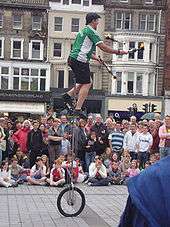
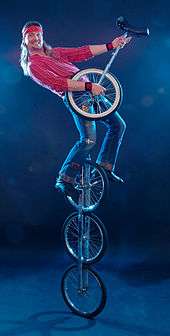
- Giraffe, a chain-driven unicycle. use of a chain or multiple wheels in a gear-like configuration can make the unicycle much taller than standard unicycles (note that multi-wheel unicycles can be described as giraffes).[5] Standard unicycles don't have a chain, which limits the seat height based on how long the rider's legs are, because there the crank is attached directly to the wheel axle. Giraffe unicycles can range in heights from 3 feet to over 10 feet high.
- Geared unicycle , or GUni, a unicycle whose wheel rotates faster than the pedal cadence. They are used for distance riding and racing.[6]
- Multi-wheeled unicycle, a unicycle with more than one wheel, stacked on top of each other so that only one wheel touches the ground (nicknamed stacks). The wheels are linked together by chains or direct contact with each other.[7] These unicycles can also be called Giraffes.
- Kangaroo unicycle, a unicycle that has both the cranks facing in the same direction. They are so named due to the hopping motion of the rider's legs, supposedly resembling the jumping of a kangaroo.
- Eccentric unicycle, a unicycle that has the hub off-center in the wheel. Putting an eccentric wheel on a kangaroo unicycle can make riding easier, and the rider's motion appear more kangaroo-like.
- Ultimate wheel, a unicycle with no frame or seat, just a wheel and pedals.
- Impossible wheel, or BC wheel, a wheel with pegs or metal plates connected to the axle for the rider to stand on. These wheels are for coasting and jumping. A purist form of unicycle, without cranks.
- Monocycle, or monowheel, a large wheel inside which the rider sits (as in a hamster wheel), either motorized or pedal-powered. The greater gyroscopic properties and lower center of mass make it easier to balance than a normal unicycle but less maneuverable.
- Self-balancing unicycle, a computer-controlled, motor-driven, self-balancing unicycle.[8]
- Freewheeling unicycle, a unicycle in which the hub has a freewheel mechanism, allowing the rider, to coast or move forward without pedaling, as a common bicycle does. These unicycles almost always have brakes because they cannot stop the way traditional unicycles do. The brake lever is generally mounted in the bottom of the saddle. These unicycles also cannot go backwards.
Other variations include:
Training aids
Training aids are sometimes used to make it easier to become comfortable with riding a unicycle. One method for training is using a spotter to make riding easier. Another method is finding a narrow hallway that can be used to help alleviate left and right balancing while allowing a beginner to focus on forward and backward balance. Equally, riding back and forth between two chairs, faced back to back, while holding on to the chair backs allows the user to gauge how to appropriately position oneself before setting off. Using props such as sticks or ski poles is generally discouraged as they hinder balance and create dependence. A fall onto props could also cause serious injury.[11]

Riding styles
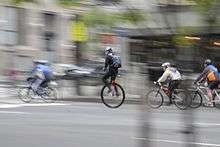
Traditionally, unicycling has been seen as a circus skill which has been performed at events to entertain the public in the circus or during parades, carnivals or street festivals. Recent developments in the strength and durability of bicycle (and consequently unicycle) parts have given rise to many new activities including trials unicycling and mountain unicycling. Unicycling is arguably now as much a competitive sport and recreational pursuit as an entertainment activity.
The principal types of unicycling are:
- Freestyle
- Perhaps the oldest form of unicycling, traditional freestyle riding is based on performance. Freestyle tricks and moves are derived from different ways of riding the unicycle, and linking these moves together into one long flowing line that is aesthetically pleasing. Competitions look very similar to figure skating.
- Comedy
- Along with freestyle it is a performance style of unicycling. Often employed by clowns and other circus skills performers. Comedy unicycling exaggerates the perceived difficulty of riding a unicycle to create a comedic performance.
- Trials unicycling
- Trials unicycling is specifically aimed at negotiating obstacles. Analogous to trials bike riding.
- Street unicycling
- Street unicycling as a style involves riders using a combination of objects found in urbanized settings (such as ledges, handrails, and stairs) to perform a wide variety of tricks. Many tricks are similar to those performed in other extreme sports, such as BMX and skateboarding.
- Off-road or mountain unicycling (abbreviated to 'MUni')
- Muni is riding on rough terrain and has developed as a form of unicycling in recent years.
- Touring or commuting
- This style concentrates on distance riding. With a 29-or-36-inch (740 or 910 mm) wheel cruising speeds of 10 to 15 mph (24 km/h) or more can easily be reached.
- Flatland
- As of 2009 This style of unicycling is similar to freestyle in that various tricks and movements are performed on flat ground. Flatland, however, does not have the performance element of freestyle, but instead has tricks that are similar to those in BMX and skateboarding.
Unicycle team sports
Unicycling is also performed as a team sport.
Unicycle basketball
Unicycle basketball uses a regulation basketball on a regular basketball court with the same rules, e.g., one must dribble the ball while riding. There are a number of rules that are particular to unicycle basketball as well, e.g., a player must be mounted on the unicycle when in-bounding the ball. Unicycle basketball is usually played using 24 inches (610 mm) or smaller unicycles, and using plastic pedals, both to preserve the court and the players' shins. In North America, regular unicycle basketball games are organized in Berkeley, San Luis Obispo, Detroit, Phoenix, Minneapolis, and Toronto. Switzerland, France, Germany and Puerto Rico are all field teams. The Puerto Rico All Star Unicycling Basketball Team has been one of the dominant teams and has won several world championships.
Unicycle hockey
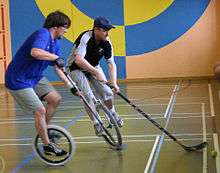
Unicycle hockey follows rules basically similar to ice hockey or inline hockey, using a tennis ball and ice-hockey sticks. Play is mostly non-contact. The sport has active leagues in Germany, Switzerland and the UK and international tournaments held at least bi-annually. Tournaments in the UK are held by various teams across the country usually in sports halls, but occasionally outside. Each tournament lasts a day and around 8 teams normally compete in a round-robin league with the winner being whoever has the most points. If two teams have the same number of points the winner can be decided by goal difference or a penalty shoot-out.
Unicycle handball
Unicycle handball uses a handball-sized ball. The teams aim to throw it into a vertical hoop placed about 6 feet (1.8 m) above the ground. It has been played in the Polish village of Chrzelice since the late 1970s[12][13]
Notable unicyclists
Known as unicyclists
Individuals
- Kris Holm and George Peck, pioneers in mountain unicycling
- Rudy Horn, a German juggler
- Ernest Montego, a German juggler
- Jiang Yan Jing, Chinese acrobat
- Lucky Diamond Rich, a tattooed performance artist
- Michael Goudeau, an American juggler
- Amy Shields, an American freestyle unicyclist
- Edward Pratt the first person to pedal around the world on a unicycle[14][15]
Groups
Known in other fields
- Adam Carolla, American comedian and actor[20]
- Rupert Grint, actor who played Ronald Weasley in the Harry Potter films[21]
- Mika Häkkinen, Formula One racing driver[22]
- Lewis Hamilton, Formula One racing driver[23]
- Eddie Izzard, comedian and actor[24]
- Leslie Mann, American actress who performed on The Ellen DeGeneres Show[25]
- Chris Martin, lead singer of Coldplay[26]
- Demetri Martin, American comedian and actor[27]
- Ulrich Mühe, late German actor, best known for his role in The Lives of Others[28]
- Michael Nesmith, former guitarist of The Monkees[29]
- Miles Plumlee, American professional basketball player[30]
- Nico Rosberg, Formula One racing driver[23]
- Donald Rumsfeld, former United States Secretary of Defense[31]
- Claude Shannon, founder of information theory[32]
- Take That members Mark Owen, Jason Orange, and Howard Donald unicycled for the circus-based video for their song "Said It All"[33]
- Andrew Tosh, son of Peter and also a Jamaican reggae musician[34]
- Peter Tosh: Jamaican reggae musician from The Wailers (1963-1974 band)[34][35]
- Steve Young, former National Football League quarterback[36]
- Ilya Zhitomirskiy: Russian-American software developer and entrepreneur[37]
UNICON and regional championships
UNICON, Eurocycle and APUC are regular international unicycling conventions.
The biennial UNICON (International Unicycling Convention), sanctioned by the International Unicycling Federation, comprises all major unicycling disciplines and is a major event on the international unicycling calendar. Events include: artistic (group, pairs, individual, standard skill, open-X), track racing (100 metres, 400 metres, 800 metres, 30 metres walk the wheel, 50 metres one-foot), 10 kilometres, marathon (42.195 km), muni (cross-country, uphill, downhill, North Shore downhill), trials, basketball and hockey.[38]
The Eurocycle (EUROpean uniCYCLE meeting) is a similar convention but based in Europe.
APUC, the Asia Pacific Unicycle Championships, are held biannually, alternately with Unicon. The first APUC, in 2007, was in Singapore. Subsequently, the event has been held in Hong Kong (2009), Seoul (2011), Canberra (2013), and Singapore (2015).
Races
The world's first multi-stage unicycle race, Ride the Lobster, took place in Nova Scotia in June 2008. Some 35 teams from 14 countries competed over a total distance of 800 km.[39] Each team consisted of a maximum of 3 riders and 1 support person.
Unicross, or unicycle cyclocross is an emerging race format in which unicycles race over a cyclocross course.
Manufacturers
Unicycle makers include:
See also
References
- ↑ "US 87355 A". March 2, 1869. Retrieved 2015-03-29.
- ↑ "US 242161 A". May 31, 1881. Retrieved 2015-03-29.
- ↑ ""To Coker" is a verb with one wheel and tire on it!". Archived from the original on 2008-03-16. Retrieved 2008-05-13.
- ↑ "Oakland man completes cross-country unicycle trek". Kennebec Journal & Morning Sentinel. 2011-08-20. Retrieved 2017-11-06.
- ↑ Foss, John. "Multi Wheeled Unicycles". Retrieved 2012-06-26.
- ↑ Holm, Kris; Schlumpf. "Schlumpf Geared Unicycle Hub". Retrieved 2012-06-26.
- ↑ http://www.unicycling.com/garage/multi.htm
- ↑ http://www.gizmag.com/go/2350/
- 1 2 "Archived copy". Archived from the original on 2009-04-17. Retrieved 2009-06-03.
- ↑ http://www.unicycling.com/garage/recumben.htm
- ↑ Wiley, Jack (1973). The unicycle book. Pennsylvania: Stackpole Books. ISBN 0-8117-0416-5.
- ↑ How it started in Chrzelice (Polish)
- ↑ Pictures of handball played by former and current members of Chrzelice unicycle team
- ↑ Pratt, Edward. "World Unicycle Tour, About". World Unicycle Tour. Retrieved 19 March 2018.
- ↑ Carlson, Kathryn. "Briton Ed Pratt becomes first person to pedal around the world on a unicycle". Retrieved 2 August 2018.
- ↑ "Wendy's Shameless Surprise Stunt: The King Charles Unicycle Troupe". The Wendy Williams Show. November 11, 2011.
- ↑ "Built to Amaze: King Charles Troupe". Ringling Brothers & Barnes & Bailey. Archived from the original on 2 October 2013. Retrieved 29 September 2013.
- ↑ "King Charles Troupe: Unicycle Basketball Troupe". Blue Moon Talen. Retrieved 29 September 2013.
- ↑ "April 26 "Lisa Tolliver Show" features Ray Aydelott, Joe Franklin and David Reid". Lisa Tolliver Show. April 24, 2006.
- ↑ 'Dancing With The Stars Eliminates Adam Carolla'
- ↑ ohne Autor (15 July 2009): 9 Fun Facts about Rupert Grint! Extra TV (retrieved 16 November 2015)
- ↑ 'Mika Häkkinen bio'
- 1 2 Lewis Hamilton relishing reunion with old unicycle rival Nico Rosberg, Guardian, 15 March 2013
- ↑ 'Eddie Izzard'
- ↑ Stephanie Palumbo (September 2012). How Leslie Mann Lives Her Best Life. The star of the new animated film ParaNorman talks about her love of unicycles, her kids, and all things supernatural. O, The Oprah Magazine (retrieved 17 November 2014)
- ↑ 'Chris Martin Rides Unicycles'
- ↑ Eric Spitznagel (7 April 2011). Demetri Martin on Twitter Battles, Kurt Vonnegut Asterisks, and Unicycle Regret. Vanity Fair online (retrieved 16 November 2014)
- ↑
- ↑ Paul Cambra (7 February 2013). Jess Riegel makes documentary about Unicycle World Championships. 'Unicon 16 Brixen' available at three Auburn bike shops. Auburn Journal (retrieved 16 November 2014)
- ↑ 'Miles Plumlee Rides a Unicycle at Duke basketball game'
- ↑ 'Donald Rumsfeld On A Unicycle'
- ↑ 'Claude Shannon obituary' Archived 2012-10-22 at the Wayback Machine.
- ↑ 'Take That Unicycle (BBC)' on YouTube
- 1 2 Babylon By Bike Don Snowden (7 April 1988). Andrew Tosh Shoulders Reggae Legacy. Los Angeles Times (retrieved 16 November 2014)
- ↑ 'Hope You Like Jamming Too (Review of Peter Tosh biography)
- ↑ 'Quarterback always called right plays'
- ↑ Paul Vitello (15 November 2011). Ilya Zhitomirskiy Dies at 22; Co-Founded Social Network. New York Times (retrieved 16 November 2014)
- ↑ International Unicycling Federation
- ↑ Ride the Lobster Archived 2008-07-26 at the Wayback Machine.
External links
| Wikibooks has more on the topic of: Unicycle |
| Wikimedia Commons has media related to Unicycles. |
